Planning, economy, place: literature review
Review of the publications and case studies regarding how planning can support the economy, and
how the economy can support creating great places.
3 Case Studies
Introduction
3.1 The Scottish Government's study brief requested four case studies that could provide examples to illustrate the research around investment and development, and quality of place, drawing out a clear narrative on the planning system's role.
3.2 The case studies are presented as short, focused summaries, highlighting the key features of planning, economy and place. Links to full project details and supporting documents are provided within each case study.
3.3 Each of the selected projects is transformative for its location. The examples have all been planned and commenced, allowing some comment on early economy and place outcomes. Each remains 'live' as it has not yet been fully completed and can be further reviewed in future.
3.4 The case studies are:
- The Borders Railway. The reinstatement of the railway from Edinburgh via Midlothian to central Scottish Borders which opened in September 2015.
- Pennywell, Edinburgh. The ongoing major housing-led regeneration project as part of City of Edinburgh Council's 21st Century Homes programme.
- Clyde Gateway. The live Urban Regeneration Company project covering eastern Glasgow and the northern part of South Lanarkshire.
- Stromness, Orkney. The multi-faceted regeneration and development of the town based upon a clear framework and facilitated by collaborative working.
The Borders Railway
Following the Beeching cuts to UK railways, the Waverley Route from Edinburgh to Carlisle through central Borders closed in 1969 after operating for 107 years. Over time the social and economic disconnection caused by this closure became apparent. Between 2001 and 2011 for example, the working age population growth in Midlothian and Scottish Borders was only 2-3%, compared with double figure growth in better connected neighbouring council areas(lxv).
The 2006 Waverley Railway (Scotland) Act triggered major investment and support from Scottish Government, Transport Scotland, local authorities, Scottish Enterprise and the rail industry, resulting in part of this historic line reopening in September 2015, renewing the connection between Edinburgh, Midlothian and central Borders.
The Borders Railway has been supported by a cascade of planning policy. NPF3 recognises the railway's role in supporting sustainable development and opening up new development sites in the central Borders. This flows into the Strategic Development Plans, which incorporate the railway as a key component of their spatial strategies. At a local level, planning policy has guided the development of the railway through spatial strategies set out in Local Development Plans across the three local authorities - Edinburgh (2016), Midlothian (2017) and Scottish Borders (2016) - which allocate business and housing sites around the route. This is supported by Supplementary Guidance, Planning Briefs and individual area designations. Area-based masterplans have been produced for Newtongrange, Galashiels and Tweedbank.
Map of borders railway
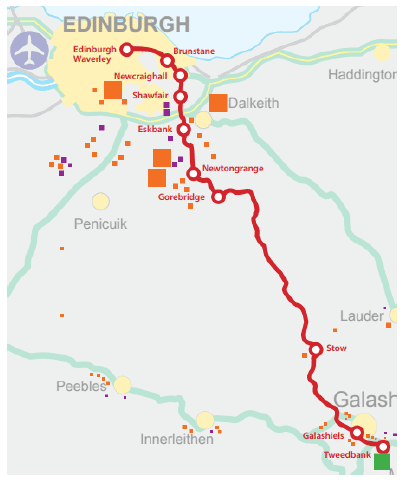
Map of borders railway including spatial context
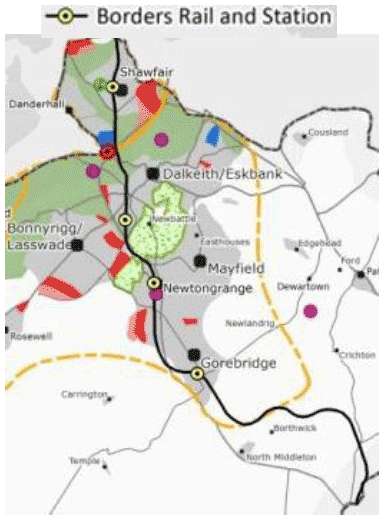
Midlothian LDP (2017) Figure 2.1
The Development planning hierarchy affecting the Borders Railway
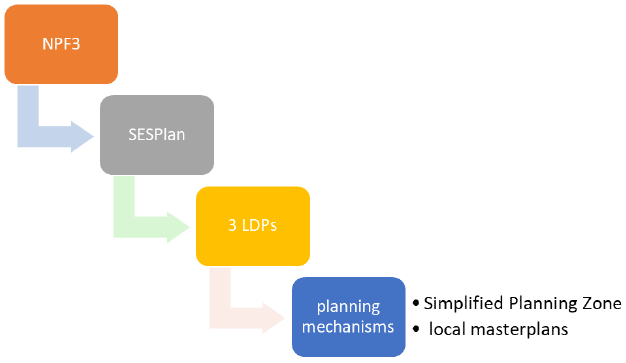
An example of local planning support is Scottish Borders Council's Supplementary Guidance for the Central Borders Business Park, Tweedbank, Galashiels. The guidance promotes a development vision based on place-making and design principles, opportunities and constraints. To maximise the impact of the railway, the Business Park has been allocated Simplified Planning Zone (SPZ) status to encourage investment through employment-led redevelopment and quick delivery.
Map of Tweedbank including the boundary of a proposed Simplified Planning Zone
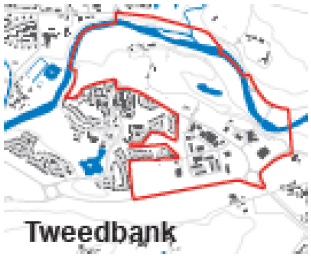
In a process evaluation of the Borders Railway(lxvi), the key success to the delivery of the project was identified as effective communication and relationship building between the three local authorities, Transport Scotland and Network Rail. This was facilitated through named points of contact, informal communication via a co-location facility at Newtongrange and formal communication through a Joint Committee and a Project Delivery Group.
To deliver economic growth objectives, the Borders Railway Blueprint was established, around the themes of great locations for working and investing, living and learning, and visiting[17]. Public consultation was extensive but as with any consultation process some communities felt less engaged. The evaluation recommends acknowledgement early in the process of planning's role in seeking high(er) standards of proposals.
The infrastructure investment involved 30 miles of new railway track, seven new stations and construction or upgrade of 137 bridges or viaducts. Assessing the economic outcomes is limited by the railway only having being operational for less than three years. Many of of the project's impacts through planning will be long term and related to the masterplanning activity reported above and below, as well as spillover benefits. Economic opportunities supported by the railway include helping to stimulate the growth of new communities at Shawfield and Redheugh, and securing funding commitment of £15 million from the Edinburgh City Region Deal to support the Central Borders Business Park. A new transport and business hubs was created in Galashiels and station buildings in Newtongrange and Stow are being considered for the provision of further business hubs. The current, early value of investments associated with the new railway is reported as £17 million.
Although not directly attributed to the railway, there has been an initial 27% rise in visitor nights and 11% increase in day visitors in Scottish Borders, and related growth in expenditure and employment. Midlothian experienced a 12% rise in visitor nights and 7% rise in day visitors[18]. New employment in specific ICT, food & drink and energy companies is also attributed to the railway. Prevention of population decline is supported by access to Edinburgh's labour market, with over 50% of users who had moved house and 80% who have moved job cited the railway as a factor in this decision[19].
The railway and its stations are a fixed infrastructure, creating clear, spatial place effects and opportunities. The planned Great Tapestry of Scotland Visitor Centre in Galashiels will highlight the importance of the textile industry to the Scottish Borders and target 50,000 visitors per year, as well as providing the catalyst for wider business initiatives, extension of Market Square and identification of new hotel sites.
Planning Aid Scotland has launched a 4-year 'Bridging the Gap' partnership with Galashiels Academy using the Place Standard Tool and matching pupils with practitioners to promote inter-generational cooperation around place planning.
To the south of Galashiels, the Tweedbank masterplan focuses on residential (400 units) and mixed use (75,000 sq.m.) development on the Lowood Estate and Central Borders Business Park.(lxvii)
In Midlothian, the local authority in partnership with the Borders Railway Blueprint Programme is completing masterplans for redevelopment of Newtongrange town centre and the neighbouring Stobhill and Lady Victoria sites to provide residential and commercial development adjacent to existing employment, leisure and tourist facilities.
A southern extension of the Borders Railway via Hawick to Carlisle, reinstating the whole line, is shown in the 2016 Scottish Borders LDP. This demonstrates continued planning for long term economic investment and place making.
Summary
The planning process for the reinstated Borders Railway supported not only the core infrastructure investment but also, crucially, created the framework to realise long run economic and social potential through a cascade of guidance and interventions, capitalising upon both the service and its halo effects around the new railway stations.
Pennywell, Edinburgh
Pennywell was a large Council housing estate in North Edinburgh, developed immediately after WW2. The rectangular site contains a number of local facilities such as neighbourhood shops, a small supermarket, a public house, schools, churches, a local library, a health centre and the North Edinburgh Arts centre.
Despite this scale and mix, a design review found that the "housing and non-housing facilities are unplanned and unattractive" and "there is no single place in the area that feels a pleasant public space"[20]. Lack of legible routes, poor internal and external connectivity, lack of attractive open or private / semi-private space, and lack of a sense of place were perceived challenges of the area.
Pennywell Housing Estate
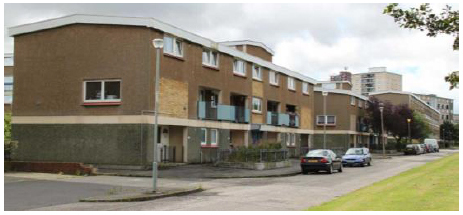
Regeneration proposals were launched during the early 2000s and Pennywell is now the largest of City of Edinburgh Councils' 21st Century Homes development projects.
At a strategic planning level, NPF3 recognises the continuing need for regeneration as a priority in Edinburgh. At a local level, the Edinburgh LDP 2016 supports large scale regeneration of Pennywell and protects the local centre for retail use.
A planning application for redevelopment to provide around 700 new mixed-tenure homes, open space, public realm and new streets was approved in 2009. The regeneration is supported by a masterplan (pictured) and a design guide which promotes social inclusion, holistic design of housing and the public realm, safe and secure spaces and environmentally sensitive design.
Pennywell Housing Estate regeneration masterplan map

A hierarchy of the planning policy relevant to the masterplan of Pennywell’s regeneration programme
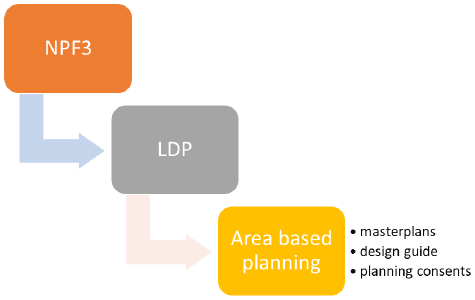
Further planning applications were submitted in 2010 for 750 new homes and in 2012 a further 250 homes plus redeveloped shopping centre and health centre. In 2017 a masterplan was submitted and approved for a new town centre/civic centre. Purchase by the Council of the dilapidated shopping centre between these masterplans was key to unlocking the full site and delivering more homes, while retaining retail and employment in the local centre.
The planning process at Pennywell includes a "you said, we did" partnership with the local community. The group has been running for almost 10 years and has guided place-making, for example by resolving tensions over building heights and inclusion of community uses.
The economic investment at Pennywell is substantial. City of Edinburgh Council procured developers Urban Union to deliver the new housing; Phase 1 is completed and Phase 2 comprising 170 new homes is now being marketed. Proximity and access to the Edinburgh city economy features strongly in Urban Union's marketing under the banner 'Pennywell Living'. An 8-year build programme is envisaged and a reported £150 million of public and private money has been invested to date. The Council's purchase of the shopping centre secured local services and employment and the Scottish Government's funding of £1.5 million contributed to a new public square. A new £12 million NHS-led North West Edinburgh Partnership Centre opened April 2018 in the local centre.
Pennywell’s proposed development
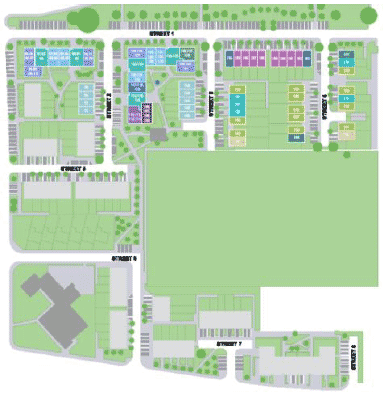
The masterplan, design documents and community engagement support the creation of a strong sense of place around the physical regeneration at Pennywell. The new homes provide a mix of family housing and flats with a maximum height of four storeys. Social integration is encouraged through tenure blind design in a 50:50 mix of mid-market/social rent and 50% for sale. There are also 96 home for older people, promoting mixed communities and helping to ease isolation.
Artists impression of Pennywell regeneration scheme
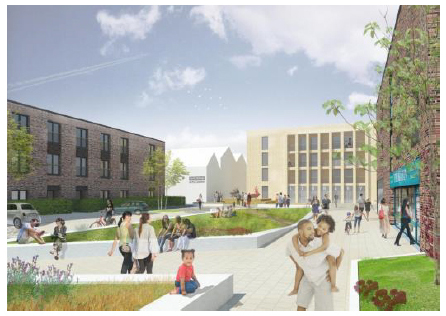
Notable community assets include a social enterprise business which operates as café during the day and a restaurant at night, and the new public square with seating areas and a community events space. Designing the square to change the dynamic of the area has been crucial to promoting active use and designing-out anti-social behaviour. A nursery and upgrading of the library will help to create and sustain a mix of uses. Promotion of health and well-being is encouraged through working with SUStrans to map out cycling and walking routes in the area. The de-dualling of Pennywell Road is being considered to reduce barriers between communities.
Summary
The planning focus upon area-wide housing-led regeneration and the failing local centre were critical for Pennywell. Consecutive masterplans and design guidance have steered collaborative working between communities, the developer and public authorities. A broad and substantial mix of public and private investment and place-creation is now emerging at Pennywell.
Clyde Gateway, Glasgow and South Lanarkshire
Clyde Gateway[21] is an 840-hectare former area of heavy industry in east Glasgow and Rutherglen. Over the period 2008-2028, Scotland's largest regeneration project is revitalising this post-industrial landscape, including some of the country's most disadvantaged communities.
Artist’s impression (aerial view) of Clyde Gateway
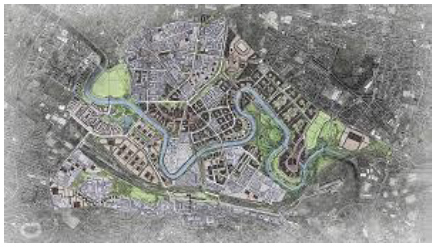
Clyde Gateway is supported and delivered through interlocking, evolving planning policy. The area is a priority in consecutive National Planning Frameworks. A 2004 masterplan (above) guides development and informs the Glasgow City Development Plans and Strategic Development Plans. Policies support mixed use regeneration and designate a Strategic Economic Investment Location (SEIL) for employment uses. Masterplans for core areas including Shawfield and Dalmarnock were produced in 2011. The Clyde Gateway Character and Values book sets our core principles. Together these support a long term strategy to tackle ingrained social and economic problems, by providing a framework for informed, evidence-based decisions and for physical regeneration.
Diagram of the evolving planning policy that affects Clyde Gateway
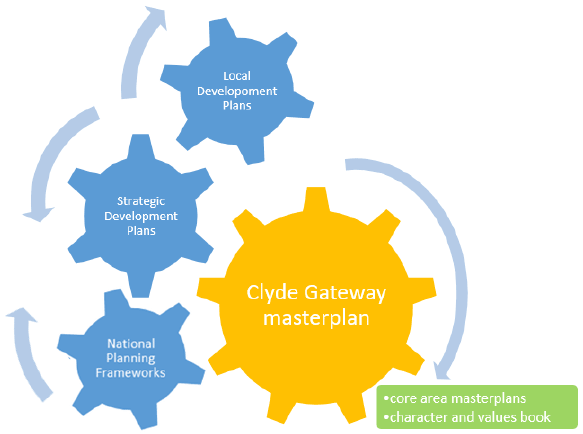
Economic regeneration of Clyde Gateway is driven by the Urban Regeneration Company (URC), a partnership form between Glasgow City Council, South Lanarkshire Council, Scottish Enterprise and the Scottish Government. The URC was established in 2008 following partnership activity 2004-07 and a commitment to physical, social and environmental regeneration which was made as a part of the Commonwealth Games bid. URC activity was initially adversely affected by the 2008/09 global financial crisis.
Major infrastructure projects have included the M74 Motorway completion, East End Regeneration Route, public transport projects, bridging of the River Clyde and major land remediation. Detailed infrastructure planning and engagement with agencies is critical in a regeneration area. Long run targets are for 10,000 new homes - in market-led formats - and for 0.4 million sq.m. of business space which is now 16% complete. Projects include new housing at the Commonwealth Games Athletes' Village, social rented housing in Bridgeton, and business space in Bridgeton, Clyde Gateway East and Police Scotland's headquarters. A wide range of interventions and funding sources has been used, although activity is now increasingly private sector-led, including institutional investment in completed development at Clyde Gateway East.
As a local example, the Shawfield area required ground-breaking chromium remediation then a 2012 masterplan for 65 hectares for a new national business district targeting 10,000 jobs. This was Scotland's largest planning application. Phase 1 pedestrian walkways and a bridge have been completed alongside streamlined planning consents for Class 4 and ancillary uses. A first new building at Shawfield, Red Tree Business Suites at Magenta Business Park (pictured) opened in 2018 and has significant occupier interest.
Red Tree Business Suites at Magenta Business Park
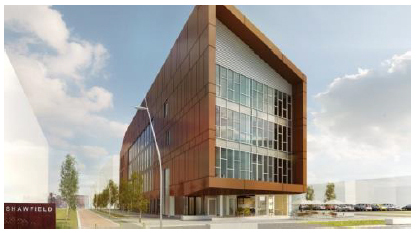
Place-making is embedded in Clyde Gateway through the suite of planning documents, in particular by 'the book' defining the area's four characters - river, crossings, history and density - and nine values. Delivery of place-making is via infrastructure-first and partnership working. Between 2008 and 2017, 239 hectares of land was remediated, local environmental projects were delivered and notable buildings re-purposed. Cunnigar Loop (pictured)[22] is a new woodland area on the banks of the River Clyde delivered by the URC and Forestry Commission Scotland. For the URC, good design and place-making works in tandem with securing development activity and should not create barriers.
Map of Cunnigar Loop, Glasgow, and around
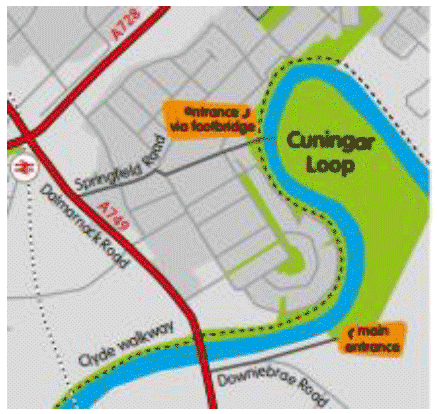
Community engagement has been critical in Clyde Gateway. The strongest community interest is in tangible matters such as employment opportunities, positive changes to localities, and local services such as shops and schools. Clear benefits delivered include working with schools to match pupils to contractors and securing apprenticeships at Magenta Business Park. More than one-quarter of 5,100 new jobs have gone to local people. Two thousand people have participated in employability programmes, and nearly 5,000 in community engagement events[23]. Embedding benefits in these ways is shown to support planning activity much better than simply consulting to seek views.
Summary
Clyde Gateway is a major city area which required comprehensive social, physical and environmental regeneration following the collapse of heavy industry. That regeneration is now being delivered by the URC and via excellent partnership working[24], and, increasingly, by the development industry. The quality and range of investment and places now emerging in Clyde Gateway testify that starting from huge disadvantage need not be a 'path dependency', and can be addressed through a long term, consistent, coordinated, plan-led programme.
Stromness, Orkney
The Orkney Islands are recognised in national planning policy as a significant asset. A series of planning policy initiatives and interventions since the early 2000s have focused on Stromness, one of two towns on the Mainland (the other being Kirkwall).
A public space in Stromness
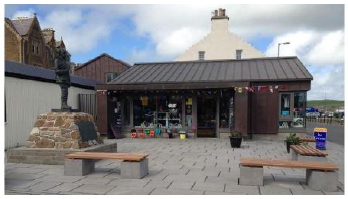
The Stromness Urban Design Framework (SUDF, extract pictured) was adopted as supplementary planning guidance in the 2011 Proposed Orkney Local Development Plan (LDP). The SUDF incorporates site specific development briefs and economic appraisals which establish core design principles, a spatial framework and incorporated community aspirations within a place-based strategy. Projects included Stromness Townscape Heritage Initiative (THI), Pierhead Regeneration, Stromness Primary School, Coop/Mart site redevelopment, Ness Battery and Orkney Research Campus.
Map of the Stromness Urban Design Framework
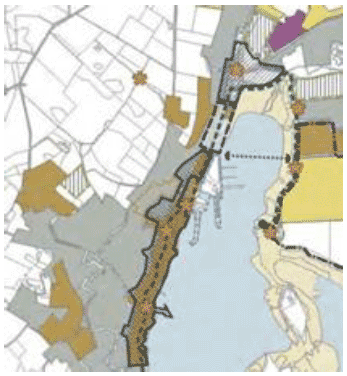
The Orkney Local Development Plan 2017 identifies and supports Stromness town centre for retail, commercial, leisure, office, community and cultural facilities, and allocates and safeguards specific sites. It makes provision for the SUDF to be reviewed and approved as supplementary guidance. Development briefs are again required for a number of sites.
This suite of documents provides plan-led guidance for development to follow. The SUDF was crucial as it created a design framework for local planning policy, land allocations and site specific guidance, allowing urban design principles to lead decision-making. The SUDF set out existing green space, urban links, green links and important places and focal points, supported by the views of the community.
Hierarchy of planning policy
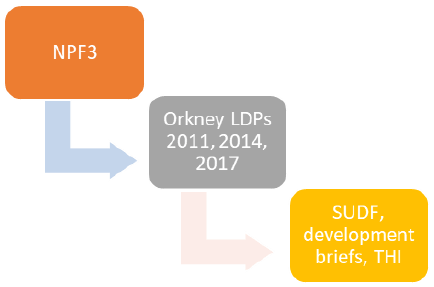
Collaborative working was promoted through Team Stromness. This initiative was coordinated by the Council's Regeneration and Development Planning teams and was made up of senior officials, elected members and managers of key Council departments. Planning professionals were key in leadership and delivering outcomes.
Community engagement was led by the Stromness Town Centre Partnership through public consultation, events and information-gathering. These helped to catalyse to a number of projects, and led to the commissioning of the SUDF. Community input then informed the SUDF and the design process.
Economic activity supported by planning include redevelopment of the former Commercial Hotel to create new commercial floorspace in the town centre and the former Stromness Auction Mart being redeveloped to include retail. Additional amenities delivered include the New Stromness Primary School (pictured) developed on the waterfront and new council housing developments. Regeneration has encouraged visitors and brought jobs, culminating in a multi-million pound investment to create the Orkney Research Innovation Campus.
New Stromness Primary School
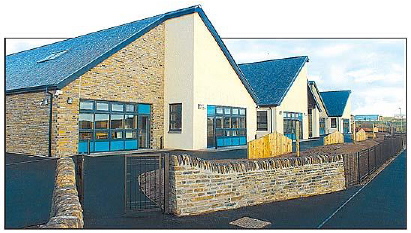
Place making was delivered not only through the SUDF and development briefs, but also the Stromness Townscape Heritage Initiative (THI, 2009 and 2014). This aimed to "deliver community aspirations for an economically successful place", through restoration of the towns historic fabric including a grant-assisted Conservation Area Regeneration Scheme and a Conservation Area Management Plan. The project was also delivered by Team Stromness, funded by £3.5 million largely from the Heritage Lottery Fund, Historic Scotland and Orkney Islands Council. In 2014 the Listed Buildings and Orkney Local List Supplementary Guidance won a Scottish Award for Quality in Planning.
Graham Place, Stromness, before and after restoration work
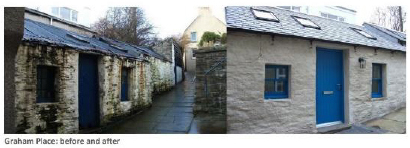
New civic space was also created at the Pierhead with public art and a performance stage as well as public buildings such as a public library and community service point.
Summary
The award-winning planning process incorporating the Stromness Urban Development Framework and the related collaboration and community engagement around a town-wide place making strategy were instrumental in delivering economy and place outcomes for the town and the Islands.
Since the research for this case study was undertaken, Stromness has won the RTPI's Silver Jubilee Cup for 2018's outstanding project across thirteen UK categories.
Contact
Email: Eric Dawson
There is a problem
Thanks for your feedback